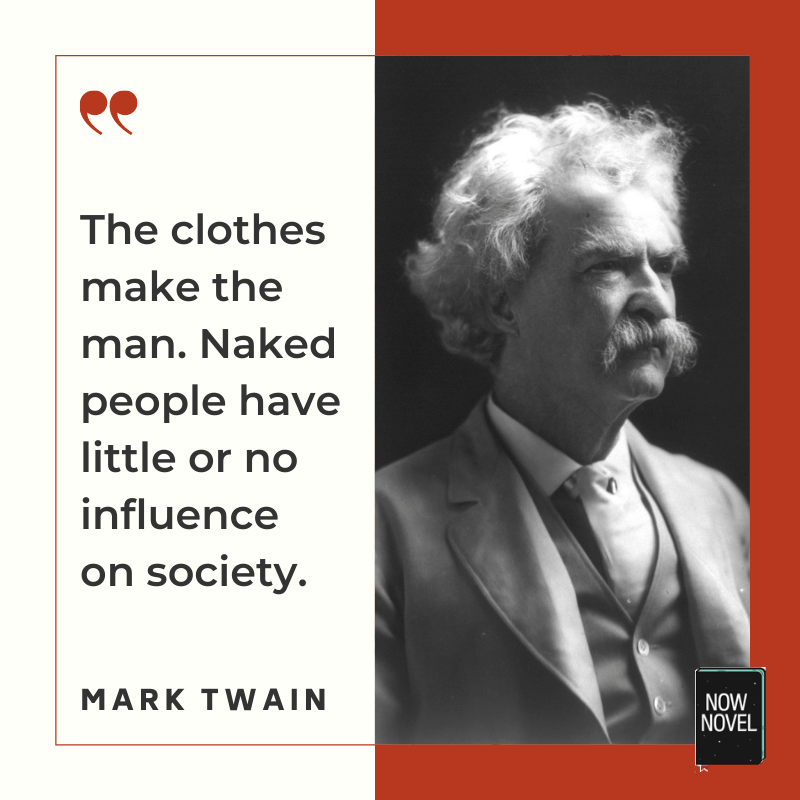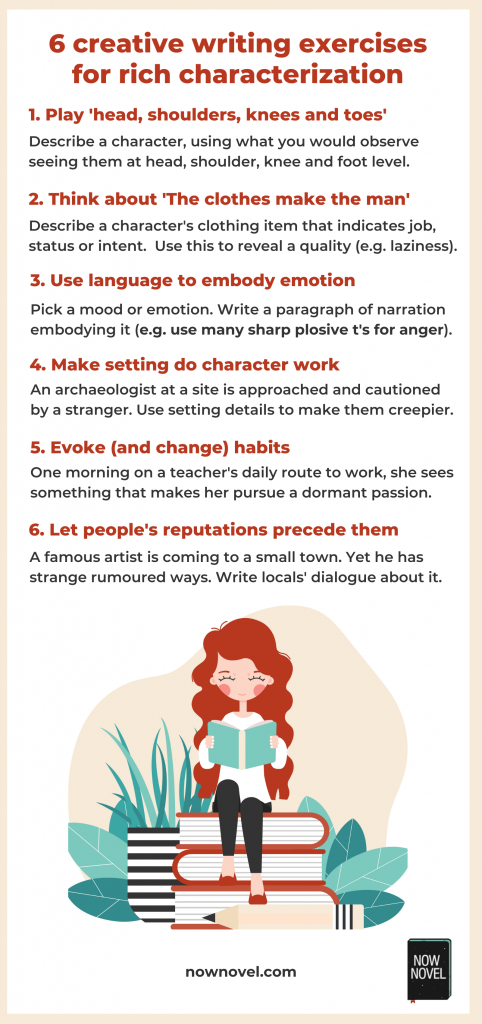In creative writing, practice is key. Try these creative writing exercises for deeper characterization. Use every detail, from appearance to movement, gesture, voice, habit, and reputation to make your characters great:
What do we mean by 'rich character'?
First, what do we mean by 'rich' character? Call it rich characterization, deep characterization - whatever superlative you prefer. We mean characterization that shows, more than tells. Conveying character using every available narrative device to build more intriguing characters.
Creative writing exercises for fuller characters:
- Play 'head, shoulders, knees and toes'
- Think about 'The clothes make the man'
- Use language to embody emotion
- Make setting do character work
- Evoke habits (and changes in them)
- Let people's reputations precede them
1. Play 'head, shoulders, knees and toes'
As children, many English speakers learn the song 'head, shoulders knees and toes'. Yet as adults, when we introduce characters we often stop at 'head'.
Beginners' character descriptions often read something like this:
'Jemima had short brown hair and violet eyes.'
As character description, this is at least factual. We know Jemima doesn't have long hair or brown eyes.
Yet, staying at head level for now, what if we said:
Jemima's new pixie cut gave her a tomboyish look. The kohl she had started wearing recently amplified the piercing and perceptive quality of her violet eyes.
Some may say the description here is too much, by comparison. Of course, each writer (and reader) must decide for themselves what is too little, or too much. Yet what this doesn't lack is concrete detail and specificity.
The description also tells us:
- What's changed about Jemima recently
- Aspects of how she performs her gender
- Character qualities suggested by appearance (intensity, intuition)
Creative Writing Exercise #1: Head, shoulders, knees and toes
Play head, shoulders, knees and toes. Describe a detail about a character at head-level in concrete terms (a hairstyle, unusual mark, wild choice of hat). Proceed to describe one detail each from shoulder level, from knee to navel, and at the level of your character's feet.
2. Think about 'The clothes make the man'
Mark Twain is alleged to have said, 'The clothes make the man. Naked people have little or no influence on society.'

Clothes, of course, make living beings of every or any gender, gender flexibility or absence of gender.
- Intent: For example, dressing formally (or infornally) for a job interview or conservatively to communicate respect for another culture
- Status or title: A queen's crown, a beauty queen's tiara
- Rank: For example, the Papal ferula or pastoral staff used by the Pope in the Catholic Church
- Personality: One person may favour concealing or baggy clothing while another prefers skimpier, revealing clothing
- Profession or educational status: A librarian's reading glasses, a chef's hat, an air steward or schoolboy's fedora
They may also suggest the opposite of what we expect.
The private slob may dress in a neat style that does not admit to their chaotic home life. Especially in the era of carefully-curated social media accounts, appearance does not always align with reality.
Consider this character description that conveys the hero Pip's sister's proud and reproachful nature in Charles Dickens' Great Expectations:
My sister, Mrs. Joe, with black hair and eyes, had such a prevailing redness of skin that I sometimes used to wonder whether it was possible she washed herself with a nutmeg-grater instead of soap. She was tall and bony, and almost always wore a coarse apron, fastened over her figure behind with two loops, and having a square impregnable bib in front, that was stuck full of pins and needles. She made it a powerful merit in herself, and a strong reproach against [her husband] Joe, that she wore this apron so much.
Charles Dickens, in Great Expectations (1861), full text available here.
Creative Writing Exercise #2: Making the clothes
For this creative writing exercise, pick one of the following items identifying a character's job, status, intent or other detail:
- A gem-studded crown
- A chef's apron
- A businesswoman's power suit
- A schoolgirl's uniform
Now write 500 words describing a charactor. Use this garment or accessory - the way they wear it, handle it (or don't wear it). Use it to show two character qualities from the following list:
- Arrogance
- Timidity
- Pride
- Laziness
- Industriousness
- Cruelty
- Kindness
- Cunning
- Carelessness
- Absent-mindedness
- Ruthlessness
- Creativity
- Rebelliousness
3. Use language to embody emotion
Building deep characterization isn't only a task for description, of course.
The rhythm, tone and quality of the language we use in narration all contribute to an impression of character.
This is especially the case in limited third person, where the narration and the third person POV character overlap.
We might narrate a clipped, brusque and brutish character in clipped, brusque and brutish phrases, for example.
Imagine, for example, a belligerent chef who dents his pots when he's in a range:
Bang. He swung another down hard on a stone counter corner. A pot's lid clattered to the floor as he plonked the dented casserole down, scowling.
Short phrases and the explosive alliteration of 'p' and 't' sounds (known as plosive consonants) create a sense of the character's jerky, angry movements.
Besides movement and the emotion in the chef's scowl, the language itself mirrors the character's mood.
Creative writing exercise #3: Using emotive language
This writing exercise is courtesy of Ursula K. Le Guin's wonderful writing manual Steering the Craft.
The exercise is given after Le Guin's following advice:
For the moment, forget all the good advice that says good style is invisible, good art conceals art. Show off! Use the whole orchestra our wonderful language offers us!
Ursula K. Le Guin, in Steering the Craft (1998), p. 17.
The character writing exercise:
In a paragraph or so, describe an action, or a person feeling strong emotion—joy, fear, grief. Try to make the rhythm and movement of the sentences embody or represent the physical reality you’re writing about.
Le Guin, Steering the Craft, p. 17.

4. Make setting do character work
Setting and character are two separate areas of writing craft, right?
Not entirely. We've already written about how to use setting to drive plot.
You can also involve setting in character description to create a richer sense of tone, mood and state of mind.
We used the following example by Barbara Kingsolver to illustrate this in our workbook How to Write Real Characters: Character description.
“Take this baby,” she said. […]
Barbara Kingsolver, The Bean Trees, p. 17.
The child had the exact same round eyes. All four of those eyes were
hanging there in the darkness, hanging on me, waiting. The
Budweiser sign blinked on and off, on and off, throwing a faint light
that made the whites of their eyes look orange.’
Kingsolver captures the moment a baby is foisted on her protagonist at a rest stop beautifully.
The neon light of the Budweiser sign, reflected in the eyes of the desperate woman and the child, add a layer of quiet pathos to their situation.
Creative writing exercise #4: Making setting do character work
An archaeologist is working at a dig site when a stranger approaches them with a strange, cryptic caution. Write their conversation. Include details from their surrounds to make the stranger creepier.
5. Evoke habits (and changes in them)
Change is a vital element of character development.
If characters stayed exactly the same throughout a story, and little else changed to at least provide contrast, it would be a boring story indeed.
People are often, of course, creatures of habit. Yet conflicts and other schisms often shake us out of routines. This is one of the reasons conflict is crucial to stories. They often supply a reason for change, a reason for story.
Consider this description of a change in habit on page one of Leo Tolstoy's Anna Karenina:
Everything had gone wrong in the Oblonsky household. The wife had found out about her husband's relationship with their former French governess and had announced that she could not go on living in the same house with him [...] The wife did not leave her own rooms and the husband stayed away from home all day. The children strayed all over the house, not knowing what to do with themselves. [...]
Leo Tolstoy, Anna Karenina (translated by Rosemary Edmonds), p. 13.
On the third morning after the quarrel, Prince Stepan Arkadyevich Oblonsky - Stiva, as he was generally called by his friends - awoke at his usual time, which was about eight o'clock, not in his wife's bedroom but on a morocco-leather couch in his study.
Details Tolstoy includes - the children's 'straying' all over the house like lost cats, Stiva alone on his 'morocco-leather' couch - provide a sense of characters' habits and changes caused by the upset of Stiva's infidelity.
Creative writing exercise #5: Evoking habits
A teacher at a local school follows the same morning routine for years, taking the same walking route to school.
One morning, something happens on their morning route that changes their life and makes them quit teaching and pursue a new passion.
For this creative writing exercise, describe the routine, what happens on their route, and their reaction.
6. Let people's reputations precede them
Gossip, rumour, or blowing someone's trumpet - these are all useful ways to introduce characters, even before they appear on the page themselves.
Anticipating the way a character will match, exceed (or entirely differ from) prejudice creates intrigue.
If a character is famous, what are they famous for? What garners public interest? If they are a notorious villain, what misdeeds are widely reported or spoken about in hushed tones?
Take, for example, the character of the famous parrot belonging to Dr Urbino in Love in the Time of Cholera:
Day after day, over and over again for several months, [Dr Urbino] played the songs of Yvette Guilbert and Aristide Bruant, who had charmed France during the last century, until the parrot learned them by heart. He sang them in a woman's voice if they were hers, in a tenor's voice if they were his, and ended with impudent laughter that was a masterful imitation of the servant girls when they heard him singing in French. The fame of his accomplishments was so widespread that on occasion distinguished visitors who had traveled from the interior on the riverboats would ask permission to see him...
Gabriel Garcia Marquez, Love in the Time of Cholera (1985), p 20.
The delight of the parrot's vast repertoire of imitations (the doctor also teaches him 'to speak French like an academician') provides a keen and lively sense of character. This imitative prowess builds the parrot's celebrity.
Creative writing exercise #6: Preceding reputations
A famous artist is coming to a small town for a residency. A amateur artist is a fan of their work but has heard of some peculiar interests and behaviours. Her neighbor asks her over the fence whether she's aware of his impending arrival, and the first woman tells her neighbour what she's heard. Write their conversation.
Once you've completed the writing prompts above, explore 10 fun writing exercises for practicing writing tenses.
Get even more exercises in prompts to build useful character profiles.









Helpfull sugestions. Have to exercise!
Laszlo - Over 4 years ago